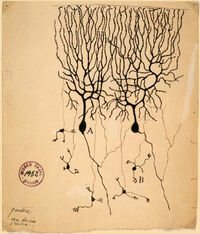No edit summary |
No edit summary |
||
| Line 1: | Line 1: | ||
| ⚫ | |||
[[Image:PurkinjeCell.jpg|thumb|right|200px|Drawing of [[Purkinje cell]]s (A) and granule cells (B) from pigeon cerebellum by [[Santiago Ramón y Cajal]], 1899. Instituto Santiago Ramón y Cajal, Madrid, Spain.]] |
[[Image:PurkinjeCell.jpg|thumb|right|200px|Drawing of [[Purkinje cell]]s (A) and granule cells (B) from pigeon cerebellum by [[Santiago Ramón y Cajal]], 1899. Instituto Santiago Ramón y Cajal, Madrid, Spain.]] |
||
| ⚫ | In [[neuroscience]], '''granule cells''' refer to tiny neurons (a type of [[Cell_(biology)|cell]]) that are around 10 micrometres in diameter. Granule cells are found within the [[Cerebellum#Granular_Layer|granular layer]] of the [[cerebellum]], layer 4 of [[cerebral cortex]], the dentate gyrus of the [[hippocampus]], and in the [[olfactory bulb]]. |
||
| ⚫ | In [[neuroscience]], '''granule cells''' refer to tiny neurons (a type of [[Cell_(biology)|cell]]) that are around 10 micrometres in diameter. Granule cells are found within the [[Cerebellum#Granular_Layer|granular layer]] of the [[cerebellum]], layer 4 of [[cerebral cortex]], the [[dentate gyrus]] of the [[hippocampus]], and in the [[olfactory bulb]]. |
||
| ⚫ | While anatomically similar, granule cells in different brain regions are functionally diverse. For instance, olfactory bulb granule cells are [[GABA]]ergic and axonless, while granule cells in the dentate gyrus have [[glutamate]]rgic projection [[axon]]s. Interestingly, these two populations of granule cells are also the only major neuronal populations that undergo [[adult neurogenesis]], while cerebellar granule cells do not. |
||
| + | |||
| ⚫ | While anatomically similar, granule cells in different brain regions are functionally diverse. For instance, olfactory bulb granule cells are [[GABA]]ergic and axonless, while granule cells in the dentate gyrus have [[glutamate]]rgic projection [[axon]]s. Interestingly, these two populations of granule cells are also the only major neuronal populations that undergo [[Neurogenesis|adult neurogenesis]], while cerebellar and cortical granule cells do not. |
||
Cerebellar granule cells account for nearly half of the [[neuron]]s in the [[central nervous system]]. Granule cells receive [[excitatory]] input from [[mossy fiber]]s originating from [[pons|pontine]] [[nucleus (neuroanatomy)|nuclei]]. Cerebellar granule cells send [[parallel fiber]]s up through the [[Cerebellum#Purkinje_Layer|Purkinje layer]] into the [[Cerebellum#molecular_Layer|molecular layer]] where they branch out and spread through [[Purkinje cell]] [[dendrite|dendritic]] arbors. These parallel fibers form thousands of excitatory [[synapse]]s with Purkinje cells. |
Cerebellar granule cells account for nearly half of the [[neuron]]s in the [[central nervous system]]. Granule cells receive [[excitatory]] input from [[mossy fiber]]s originating from [[pons|pontine]] [[nucleus (neuroanatomy)|nuclei]]. Cerebellar granule cells send [[parallel fiber]]s up through the [[Cerebellum#Purkinje_Layer|Purkinje layer]] into the [[Cerebellum#molecular_Layer|molecular layer]] where they branch out and spread through [[Purkinje cell]] [[dendrite|dendritic]] arbors. These parallel fibers form thousands of excitatory [[synapse]]s with Purkinje cells. |
||
| + | |||
| ⚫ | |||
Layer 4 granule cells of the cerebral cortex receive driving inputs from thalamus and convey driving inputs largely to supragranular layers 2-3, but also to infragranular layers of the cerebral cortex. |
Layer 4 granule cells of the cerebral cortex receive driving inputs from thalamus and convey driving inputs largely to supragranular layers 2-3, but also to infragranular layers of the cerebral cortex. |
||
==External links== |
==External links== |
||
| − | * {{BrainMaps|Granule%20cells}} |
+ | * {{BrainMaps|Granule%20cells|Granule cells}} |
| + | |||
| + | {{Nervous tissue}} |
||
[[Category:CNS neurons]] |
[[Category:CNS neurons]] |
||
[[Category:Cerebellum]] |
[[Category:Cerebellum]] |
||
| + | |||
| − | {{Neuroscience-stub}} |
||
| + | |||
| + | :de:Körnerzelle |
||
| + | :ru:Гранулярная клетка |
||
{{enWP|Granule cell}} |
{{enWP|Granule cell}} |
||
Revision as of 09:20, 10 February 2007
Assessment |
Biopsychology |
Comparative |
Cognitive |
Developmental |
Language |
Individual differences |
Personality |
Philosophy |
Social |
Methods |
Statistics |
Clinical |
Educational |
Industrial |
Professional items |
World psychology |
Biological: Behavioural genetics · Evolutionary psychology · Neuroanatomy · Neurochemistry · Neuroendocrinology · Neuroscience · Psychoneuroimmunology · Physiological Psychology · Psychopharmacology (Index, Outline)

Drawing of Purkinje cells (A) and granule cells (B) from pigeon cerebellum by Santiago Ramón y Cajal, 1899. Instituto Santiago Ramón y Cajal, Madrid, Spain.
In neuroscience, granule cells refer to tiny neurons (a type of cell) that are around 10 micrometres in diameter. Granule cells are found within the granular layer of the cerebellum, layer 4 of cerebral cortex, the dentate gyrus of the hippocampus, and in the olfactory bulb.
While anatomically similar, granule cells in different brain regions are functionally diverse. For instance, olfactory bulb granule cells are GABAergic and axonless, while granule cells in the dentate gyrus have glutamatergic projection axons. Interestingly, these two populations of granule cells are also the only major neuronal populations that undergo adult neurogenesis, while cerebellar and cortical granule cells do not.
Cerebellar granule cells account for nearly half of the neurons in the central nervous system. Granule cells receive excitatory input from mossy fibers originating from pontine nuclei. Cerebellar granule cells send parallel fibers up through the Purkinje layer into the molecular layer where they branch out and spread through Purkinje cell dendritic arbors. These parallel fibers form thousands of excitatory synapses with Purkinje cells.
Layer 4 granule cells of the cerebral cortex receive driving inputs from thalamus and convey driving inputs largely to supragranular layers 2-3, but also to infragranular layers of the cerebral cortex.
External links
- de:Körnerzelle
- ru:Гранулярная клетка
| This page uses Creative Commons Licensed content from Wikipedia (view authors). |